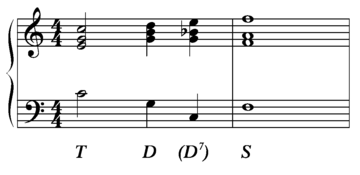Ellipse (music)
Under ellipse ( Greek ἔλλειψις élleipsis "absence", "omission") one understands in music theory the lack of an expected harmony in a harmony course, whereby this expected harmony is usually the continuation or dissolution of an intermediate dominant. The term is used in music theory according to its linguistic meaning, see ellipse (linguistics) . In romantic music , ellipses are a stylistic device that is often used.
Example:
The expected harmony in the 2nd bar is the subdominant after the intermediate dominant (3rd chord):
Ellipse : the expected subdominant is missing, instead the subdominant parallel appears:
For notation in music analysis see functional theory
Sources and literature (chronological)
- Christoph Bernhard: Tractatus compositionis augmentatus . Ms. ( online edition Bernhard Lang) .
- Johann Gottfried Walther: Musical Lexicon. Deer, Leipzig 1732 ( archive.org ).
- Reinhard Amon: Lexicon of harmony. Reference work on major minor harmony with analysis codes for functions, levels and jazz chords. Doblinger et al., Vienna et al. 2005, ISBN 3-900695-70-9 , p. 138 and p. 330.
Remarks
- ↑ Elisabeth Egger: Theories of extended tonality and vague chords in the harmony teachings of Hugo Riemann, Heinrich Schenker and Arnold Schönberg. Graz 2008 (Graz, University of Art, Master's thesis, 2008; digitized version (PDF; 2.3 MB) ).

